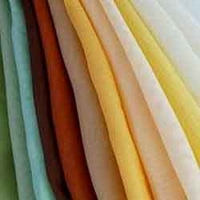
Cambric is a stiff fabric that is made up of tightly woven cotton or linen and is designed to have a glossy top side. The elaborate manufacturing process (which has been replaced with simpler, more modern applications) has made authentic cambric difficult to find. Most of the cambric that is available is often of substandard quality.
Tightly woven cotton undergoes calendaring, a process in which fabric is run through a number of hot rollers that aligns the fibers in the same direction. This is what gives the material its tight, shiny appearance.
Not to be confused with chambray, which is a variation of cambric. It consists of a looser weave of colored threads. Chambray is not run through hot rollers, which results in a fabric that remains soft and pliable.
Both chambray and cambric were named after the city of Cambrai, a city located in Southern France that is credited with the creation of the fabrics.
Even if the furniture in your home isn’t upholstered in cambric, the fabric is still more than likely present. Cambric is the material that you often see on the underside of furnishings to keep stuffing from falling out and dust from gathering on the bottom.
If you’re the weekend warrior type and you plan on upholstering (or re-upholstering) furniture with cambric, buy more of the fabric than you intend to use. Fold the excess and store it under the furniture before applying the underlying piece of cambric. This way if you ever need to make a repair or re-upholster it, you will have the exact match within arms reach.
Because of cambric’s decline in popularity, chambray has often been seen in clothing and upholstery alike. Shirts made of chambray were especially popular in the 1980’s and 1990’s.
Depending upon your style or intended use, you’ll be well off incorporating either of the two fabrics into your home.
